Mark Sisson's Blog, page 330
August 14, 2013
7 Things You May Be Doing That Impair Workout Recovery
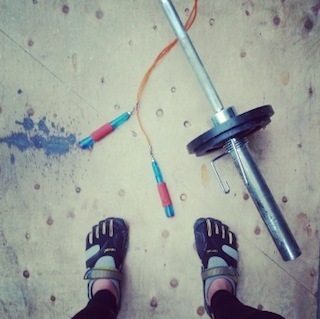 Simplicity is baked into the Primal Blueprint by design. You eat plants and animals, avoid grains, get plenty of sleep and sun, and spend time doing things you love with people you love, and things just kind of fall into place. You can tinker around the edges and get really into the details, but I try to make this stuff as simple as possible. I’ve especially tried to distill exercise, a notoriously contentious topic, down into a simple, “universal” recommendation – move frequently at a slow pace throughout the day, lift heavy things twice or thrice a week, and sprint once in a while. While I maintain such a regimen will get most people reasonably fit and let them recover easily from their workouts without having to think too hard about recovery, it’s not the same for everyone. Some folks, particularly my harder-charging readers, my CrossFitters, my endurance athletes, and my barbell fanatics could use a more detailed discussion on workout recovery (since, after all, recovery is everything).
Simplicity is baked into the Primal Blueprint by design. You eat plants and animals, avoid grains, get plenty of sleep and sun, and spend time doing things you love with people you love, and things just kind of fall into place. You can tinker around the edges and get really into the details, but I try to make this stuff as simple as possible. I’ve especially tried to distill exercise, a notoriously contentious topic, down into a simple, “universal” recommendation – move frequently at a slow pace throughout the day, lift heavy things twice or thrice a week, and sprint once in a while. While I maintain such a regimen will get most people reasonably fit and let them recover easily from their workouts without having to think too hard about recovery, it’s not the same for everyone. Some folks, particularly my harder-charging readers, my CrossFitters, my endurance athletes, and my barbell fanatics could use a more detailed discussion on workout recovery (since, after all, recovery is everything).
Today, I’ll start that discussion with a focus on seven factors that can impair your workout recovery:
Stress
Exercise is a potent stressor, and that’s why it works so well: by encountering and overcoming the stress of a heavy squat, or a sprint uphill, or an arduous hike, our fitness improves to make the next encounter a little easier. Unfortunately, dealing with any kind of stress diverts valuable manpower away from workout recovery.
I’m not making this up, folks. This isn’t just a guess of mine. Recent research confirms that “mental stress” impairs workout recovery, and it doesn’t speak in generalities. 31 undergrads were assessed for stress levels using a battery of psychological tests, then engaged in a heavy lower body strength workout. At an hour post workout, students in the high stress group had regained 38 percent of their leg strength, while students in the low stress group had regained 60 percent of their strength back. An earlier study showed that tissue healing – which our muscles must do in order to recover – is impaired during times of stress. Students received puncture wounds to their mouths, and half went on vacation and the other half had exams. On average, the exam group took three days longer for their wounds to heal. You aren’t healing puncture wounds (usually) after training, but the muscle recovery process is extremely similar and places similar demands on the body.
More Workouts
Sometimes, people get the funny notion that the benefits of exercise accrue as you exercise – in real time. These people often assume that more is always better, and that a surefire way to get lean and fit is to cram as much exercise into your schedule as humanly possible, because it’ll only make you fitter. These are the people you see spending hours at the gym every day on the same machines, using the same weights, looking and performing the same, year after year. Well, they’re wrong. Fitness accrues after workouts and during recovery. You don’t get stronger, faster, and fitter working out. You get stronger, fitter, and faster recovering from working out. And don’t be misled by those incredibly fit and strong folks who seem to train all day, every day. They’re not fit because they train that way. They train that way because they’re fit enough to do it.
As a general rule, the harder the workout, the longer the recovery period required.
Excessive Calorie Restriction
“Eat less, move more” is the popular, inevitable refrain from fitness “experts” giving weight loss advice. They claim that reducing your calorie intake and increasing your activity will always lead to simple, easy, inevitable fat loss. And yeah, that’s one way to lose body weight, but there’s one big problem with this equation: you need calories to recover from your workouts. Not a problem if you just want to lose body mass at any cost. Disastrous, though, if you want to improve performance, get stronger, and get fitter, because you need those calories to refuel your muscles and restock your energy reserves.
Plus, inadequate calorie intake coupled with intense exercise sends a “starvation” signal to the body, causing a down-regulation of anabolic hormones. Instead of growing lean mass and burning body fat, starvation (whether real or simulated) promotes muscle atrophy and body fat retention. Either alone can be somewhat effective, but combining the two will only impair recovery.
Inadequate Protein
Your muscles move you, which is why no matter what type of training you do – endurance, strength, MovNat, hillwalking, dancing, Zumba, Tabata skipping, competitive tag, Ultimate Frisbee, long duration room pacing – your muscles need to recover. Some workouts require less muscle recovery, sure, but every form of physical movement uses skeletal muscle. Muscle needs protein to repair itself and recover from exercise; this is perhaps the most fundamental concept in exercise recovery.
How much protein do you need to recover from a workout, exactly? As I said earlier, it depends on what kind of workout you’re trying to recover from. Strength training probably merits more protein than hiking, for example. According to research in athletes, anywhere between 1.8 grams protein/kg bodyweight and 3 g/kg suffices. And if you are practicing calorie restriction while exercising, increasing your protein intake can ameliorate the muscle loss that tends to accompany it.
Lack of Sleep
I recently penned a post devoted exclusively to the importance of sleep on fitness performance. The gist of it was that sleep loss doesn’t always impair performance, but it does impair recovery from exercise. Sleep debt impairs exercise recovery primarily via two routes: by increasing cortisol, reducing testosterone production, and lowering muscle protein synthesis; and by disrupting slow wave sleep, the constructive stage of slumber where growth hormone secretion peaks, tissues heal and muscles rebuild. That’s probably why sleep deprivation has been linked to muscular atrophy and increased urinary excretion of nitrogen, and why the kind of cortisol excess caused by sleep deprivation reduces muscle strength.
Additionally, sleep loss can increase the risk of injuries by decreasing balance and postural control. If you trip and fall, or throw out your back due to poor technique, you won’t even have a workout to recover from.
Nutrient Deficiencies
Active people are “living more,” which puts greater demands on the body and increases the amount of “stuff” it must do to maintain health and basic function. Since every physiological function requires a micronutrient substrate – vitamin, mineral, hormone, neurotransmitter, etc. – and physiological functions increase with exercise and recovery, active people require more micronutrients in their diet. “More of everything” is a safe bet, but there are a couple key nutrients that working out especially depletes:
Zinc: Exercise, especially weight training, works better with plenty of testosterone on hand to build muscle and develop strength. Zinc is a key substrate for the production of testosterone, and studies show that exercise probably increases the need for zinc. In fact, one study found that exhaustive exercise depleted testosterone (and thyroid) hormones in athletes, while supplementing with zinc restored it.
Magnesium: Magnesium is required for a number of physiological processes related to workout recovery, including oxygen uptake by cells, energy production, and electrolyte balance. Unfortunately, as one of the main electrolytes, lots of magnesium is lost to sweat during exercise. The same could be said for other electrolytes like calcium, sodium, and potassium, but most people get plenty of those minerals from a basic Primal eating plan. Getting enough magnesium, however, is a bit tougher, making magnesium deficiency a real issue for people trying to recover from workouts.
Infrequent Workouts
You know this specimen: the weekend warrior. Every other weekend or so, he gets amped up and goes on a big bike ride, does a 10k, swims a few thousand meters, attempts to deadlift twice his body weight, tries to climb the local mountain, or performs some other impressive feat of human endurance/strength/pain tolerance that he hasn’t done for months. He feels great doing it and feels incredibly accomplished, but by the time Monday rolls around he’s wracked with crippling DOMS that prevents him from performing simple physical tasks like shoe-lacing and back-scratching, let alone going to the gym for an actual followup workout. Since he can’t work out – or even lift his arms over his head – it’ll be another couple weeks until he exercises again. By then, any progress he made has already disappeared. He’s back at square one.
The presence of any one of these factors in your life can and likely will affect your workout recovery. Having several – or all – of them? Good luck with that.
Next time, I’ll talk about some recovery tactics. Thanks for reading, folks. Be sure to chime in with any thoughts you have on impediments to workout recovery!
Have You Seen the New Book? Get Your Copy of The Paleo Primer and Claim Your FREE Gifts While the Special Offer Lasts

August 13, 2013
Primal Peak Performance: Breaking Through to the Next Level
 Is feeling “good”, good enough? Or could there be a next level of performance and health awaiting you? This is a guest post from Dr. Cate Shanahan, one of the world’s leading primal/paleo-aligned MDs, noted author and speaker on ancestral health principles, and family practice physician in Napa, CA. Cate also designed and now serves as medical director of the
Los Angeles Lakers
cutting edge PRO-Nutrition program. She co-authored (with her writer husband Luke Shanahan) the grass roots sensation
Deep Nutrition – Why Your Genes Need Traditional Food
, and followed it up with the excellent practical shopping and food preparation guidebook,
Food Rules
.
Is feeling “good”, good enough? Or could there be a next level of performance and health awaiting you? This is a guest post from Dr. Cate Shanahan, one of the world’s leading primal/paleo-aligned MDs, noted author and speaker on ancestral health principles, and family practice physician in Napa, CA. Cate also designed and now serves as medical director of the
Los Angeles Lakers
cutting edge PRO-Nutrition program. She co-authored (with her writer husband Luke Shanahan) the grass roots sensation
Deep Nutrition – Why Your Genes Need Traditional Food
, and followed it up with the excellent practical shopping and food preparation guidebook,
Food Rules
.
Dr. Cate’s unique approach to wellness is centered upon a nutrient-intense eating strategy she calls “The Four Pillars of World Cuisine”. Cate blends her formal medical training and scientific research (in biochemistry and genetics at Cornell) with insights she learned practicing medicine and studying ethnobotany at the National Tropical Botanical Garden on the island of Kauai. In particular, she noticed the exceptional health and work capacity of the population she served in rural Kauai, who ate a superior diet of pasture raised animals and locally grown produce, and lived a low stress lifestyle.
Cate and Luke will join us at PrimalCon Vacation Tulum , where Cate will deliver a keynote lecture on the Four Pillars and Luke will conduct an intensive workshop for aspiring writers.
I’ve been a fan of Mark Sisson for a long time but I first became associated with Primal Blueprint Publishing through Managing Editor Brad Kearns several months ago. In discussing my medical practice and my Four Pillars strategy to optimize dietary habits, Brad mentioned to me that he had some strange adverse findings on his blood tests. By all accounts, Brad would be considered a healthy, athletic, and Primal-aligned guy – he was a national champion and #3 world-ranked pro triathlete back in the 90s, coached by Mark Sisson!; today at age 48 he participates in high jump, sprinting, and basketball.
With the ancestral health movement in full swing, the CrossFit Games selling out large stadiums and being nationally televised, there is a growing population of folks who are super fit, eat a nutrient-dense, Primal/paleo style diet, but may be unknowingly falling short of peak performance and optimal health. When Luke and I approached the Los Angeles Lakers, this was essentially our pitch to the team training staff – that they had some of the most magnificent and finely-tuned physical specimens in the world on their squad, but that the team, and each individual player, were quite likely missing opportunities for optimal performance and recovery in their diets.
Everyone involved in professional sports – coaches, athletes, trainers – will tell you that recovery is everything at the elite level. While Kobe Bryant has done some amazing things on the court over 1,200 games and 17 seasons, his equally amazing off court discipline keeps him in the game – his intensive workout regimen, and the hours devoted to rehab and recovery practices each day are what enable him to maintain the highest level of play for years and years.
This article is directed to those of you who may be doing things really well overall, performing in a manner that the “average” person would marvel at, but may still be unknowingly falling short of your potential. You may not have any adverse blood findings laying around, but you can certainly ask yourself some important questions: Are you stalled with weight loss progress? Do you have energy level swings relating to workouts, or meals? (One important marker for my athletic patients is to determine if they get hungry a few hours after eating, something that can indicate your metabolism may not be nimble enough to provide you with the energy you need). Do you have any difficulty getting to sleep, staying asleep, or waking up refreshed and energized? Even if things are great, could they possibly be even better?
While Brad’s blood panels showed some awesome numbers after five years of Primal eating and exercise (a triglyceride-to-HDL ratio that was even better than the optimal goal of 1:1; and triple the testosterone he had from age 26 when he was mired in an extreme endurance training regimen), he also revealed some significantly below normal range values for assorted white blood cell values (white blood cells, neutrophils, fibrinogen), as well as elevated fasting glucose (strange for an extremely Primal-aligned/cyclic ketogenic eater).
These lab abnormalities are, to me, red flags. Unfortunately they usually do not draw the attention I believe they deserve. Possibly because they are so common, many docs have gone numb to the possibility that they could mean anything. Or, they may be misattributed to genetics. It doesn’t help that physicians, dietitians and other professionals – at least those who rely solely on their formal training – remain under-educated in the fields of nutrition and metabolism. When I track down old reports of previously done labs on my new patients, the paper trail often shows they’ve had these kinds of warning signs for years.
A doctor lacking nutritional/metabolic expertise is not a criticism – it’s simply not part of their formal training. You could just as easily assume they know nothing about sailing or skydiving. When I started my medical practice, I didn’t have a clue about nutrition or metabolism either. The only reason I have a clue now is thanks to time spent – about five years – updating my education, accomplished by reading a small library’s worth of textbooks and articles from Medline and attending medical meetings held by relatively enlightened societies like the American Academy of Bariatric Physicians and the Nutrition and Metabolism Society. Much of what I learned is now compiled into the two books I’ve co-authored with my husband Luke.
Lab findings like those Brad delivered are likely due to a significant mismatch between nutrition input and metabolic output and I take them seriously because they are powerful gauges of metabolic health. The bone marrow must pump out enough white blood cells to keep our counts between 4,000 and 11,000 WBC per millimeter of blood, and it takes 20-plus hormones to regulate blood sugar. The inability of a person’s diet to keep up with the demands of these two very active metabolic enterprises usually does not lead to significant health problems – until a person experiences major stress.
I have learned that these two tests and a handful of others that I use act like metabolic crumple zones where the pressure of a persons daily routines impact upon a less-than-optimal diet (i.e. not inclusive of all Four Pillars) with visible consequences. Like a car deliberately engineered to collapse at certain points to best protect the driver during an accident, these metabolic crumple zones take the hit first when your metabolism is beginning to crash. This metabolic engineering works so well that you may not feel anything wrong – if you don’t push yourself that hard. But commonly, as in Brad’s case, a bout of athletic competition and peak performance, high-energy output is followed by troughs of low energy, fatigue and even the occasional “burnout headache” as Brad described.
Fortunately, the health consequences that arise from metabolic imbalances related to voluntary, athletic outputs that demand more nutrition than the body inputs tend to be short lived. What was likely contributing to Brad’s burnout experience were muscle catabolism (breaking down muscle) and inability to hold on to electrolytes like calcium in the aftermath of his super high intensity workouts of strength training. While Brad’s reported dietary intake was your basic Primal A+ diet (carb conscious, lots of top quality – and not overcooked – grassfed beef and pastured eggs; abundant servings of fresh produce; snacks like macadamia nuts and dark chocolate, and an absence of nutrient depleting foods) I realized, like some other hard-core athletes I treat, that he was pushing his body to the point where he needed not just a great diet, but an optimized one. This is where the Four Pillars come in.
The Four Pillars of World Cuisine detailed in Deep Nutrition represent how successful cultures use the same four strategies to optimize the nutrition they could extract from their surroundings. They are:
Fresh
Fermented and sprouted
Meat on the bone
Organ meats
Each of these categories of foods offer a variety of unique benefits, but to give you a taste I’ll share one example from all four categories. Fresh foods are the best sources of antioxidants. Fermented foods offer probiotics. Meat on the bone offers glycosaminoglycans, which trigger collagen development in joints. And organ meats are such intense sources of nutrition they make many other so-called super foods pale by comparison.
Our ancestors’ survival depended, ultimately, on their personal health and vitality. People like to talk about how our lives are so stressful these days. While they’re undoubtedly correct, life has always been stressful. Your village would get invaded, your cousin would get eaten by an alligator, you’d deal with droughts/floods/mosquito born illness, epic battles and on and on. But our primal ancestors managed to survive in spite of all that largely because of the way they ate. And according to the best available evidence from modern science, cultures around the globe included foods from all Four Pillars.
Flash forward to a person today with low WBC (or any of the other subtle abnormalities that typically get ignored) due to the dietary input-metabolic output mismatch – something I see particularly often in adults in their 30-50s and even in those who consider themselves pretty healthy (i.e., paleo-style) eaters. How will he or she handle serious stresses? Even with one or more important metabolic indicators out of alignment, people can go about their business, exercise, work, and keep up with their kids until… something really bad happens. And then, something else really bad happens. And something else. If the stress is unrelenting then, in the aftermath when things finally calm down and the body’s cortisol levels plummet, the consequences upon a person’s health can get pretty devastating.
Life is still is as unpredictable today as it always has been, so we still would benefit from fortifying our bodies pro-actively like our ancestors did. But we don’t. Our culture is re-active, not proactive. Most people wait until something happens to consider making a change. We don’t value optimal nutrition and so have largely forgotten what it even looks like.
I believe that’s why, just about every day, I hear a story of an unbelievable sequence of bad-luck events that are soon followed by life changing health problems. Yesterday’s came from a woman in her fifties who got divorced, then her best friend got cancer, then her son got married to someone she doesn’t get along with, her mother had to go into a nursing home, and somewhere in there she fell off a curb, fractured her ankle and lost her job temporarily – all this in one year. Two years ago, she was fine. Now she’s in my office with a painful and fatiguing auto-immune syndrome that specialists from the Mayo clinic are treating with several powerful immune system suppressing medications, and in spite of those meds just getting dressed in the morning is a painful exercise.
Would this have happened to her if someone had noticed those metabolic crumple zones beginning to wrinkle and optimized her diet? No one can say for sure. But in my view, the odds that significant stress will lead to life-changing health repercussions are greatly increased by ignoring the warning signs and failing to fortify your diet with the same foods are ancestors ate.
Of course, some people have the genetic good fortune to handle stress (not to mention perform physically) better than others. Take world-class athletes who stress their bodies to the limit on a daily basis. They don’t often get outright sick, but they might not have the energy they want game after game, or have the extra energy to play with their kids after workouts. Many turn to sugary blasts of candy or soda on a regular basis, not realizing that they’ve entered a Faustian contract with their metabolism. Before they realize it, this one wrong turn – making a regular habit of sugary treats – has led to metabolic changes that can make the difference between playing another 3-5 years, or finding themselves replaced by a younger, fresher athlete.
But not for players with the Los Angeles Lakers. Thanks to head trainer Gary Vitti’s, the Lakers take a proactive approach to health optimization and in 2012 Vitti invited Luke and I to join a team that includes head strength and conditioning coach Dr. Timothy DiFrancesco and Chef Sandra Padilla. Our coordinated efforts are bringing Deep Nutrition to the Lakers, and those players who are able to make changes have noticed dramatic improvements in their energy levels.
The Lakers had some troubles with injuries last year, so our PRO Nutrition (Performance Recovery Orthogenesis) team can’t brag about any titles just yet. But just wait until Kobe comes back from his Achilles tear stronger than ever! I should also mention Steve Blake and his wife Kristen, who really embraced healthy eating with full intensity. At the beginning of the 2012-13 season, Steve struggled with injuries that kept him on the bench. By the end of the season, he was performing at a career best level (making 42% of his three-pointers) such that they were calling him the White Mamba!
In Brad’s case, he had been almost entirely missing out on two of our Four Pillars. So I recommended he start adding them in by upping his intake of mineral- and glycosaminoglycan-rich bone broths and nutrient intense liver from pastured animals. I made a few other recommendations and less than a month later, after years of being low, his WBC have finally normalized. Normalizing glucose can take longer, and can take dedication to staying on the Four Pillar path. But in my experience, it’s a road well worth traveling.
Join Dr. Cate and Luke Shanahan at PrimalCon Vacation Tulum Mexico next March and Get Personalized Advice on How to Optimize Your Eating Strategy

August 12, 2013
Dear Mark: Soy-Fed Eggs, and Liver-Polluting, Body-Acifiying, Meditative State-Preventing Meat
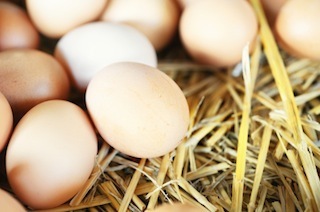 We’ve got a two-parter for today’s edition of Dear Mark. First, I field a question from a reader who loves eggs, raises his own chickens on open pasture, and wants to know whether or not the soy he currently includes in their diets is going to affect him. Then I evade a silly question about the stagnating, putrefying qualities of rotting animal flesh and explore whether meat truly does raise uric acid levels, thereby interrupting our pursuit of satori and maybe giving us gout.
We’ve got a two-parter for today’s edition of Dear Mark. First, I field a question from a reader who loves eggs, raises his own chickens on open pasture, and wants to know whether or not the soy he currently includes in their diets is going to affect him. Then I evade a silly question about the stagnating, putrefying qualities of rotting animal flesh and explore whether meat truly does raise uric acid levels, thereby interrupting our pursuit of satori and maybe giving us gout.
Let’s go:
Hi Mark,
I am currently doing about a dozen eggs per day (along with other primal friendly foods). We raise chickens and allow them to pasture happily and freely while also supplementing their diet with an organic soy based feed. Where my concern comes in is the soy content in the eggs. I hate not to use them since these chickens do produce pastured eggs. I am currently on the hunt for a soy free feed so this should no longer be an issue in short time to come. In the mean time, I have found another source of soy free pastured eggs; I use these and my family uses the eggs our chickens produce. Currently doing a dozen eggs per day, should I be worried about the the soy content in these eggs? I am not intolerant to soy just concerned about phytoestrogens I would be taking in on a daily basis. Thank you for your time really love and enjoy MDA!!
Hunter
I have good news: you probably don’t have to worry about the phytoestrogens.
Sure, soy phytoestrogens show up in eggs from soy-fed chickens, but it’s a pretty small amount. A few years ago, a study (PDF) showed that while chickens fed supplementary soy phytoestrogens produced eggs with high levels of phytoestrogens in the yolks (nearly 1000 mcg/100 grams yolk), chickens on a standard 25% soy diet produced yolks with just 46 micrograms of phytoestrogens for every 100 grams of yolk. An egg yolk runs about 20 grams or so, so with your 12 yolk-a-day habit you’d be getting a little over 100 mcg of phytoestrogens. That pales in comparison with the amount of soy phytoestrogens (or isoflavones) in most soy supplements, which have about 50 milligrams of pure phytoestrogens per serving and are designed to elicit physiological effects. It also doesn’t really compare to the 15-50 mg/day phytoestrogen intake of people who actually eat soy, nor the even higher levels used in clinical trials. While it’s possible that you may be extremely sensitive to phytoestrogens, I’ll bet you can safely save your money and eat your own eggs without worrying about growing breasts.
That said, there is one bigger problem with soy-fed chickens and their eggs, and it rhymes with “Jomega Fix.”
Chickens are the kind of animal that incorporates the fatty acid profile of whatever it eats into its own tissues. Pigs and people are the same way. There’s some endogenous conversion of fats, but by and large if they and we eat a bunch of polyunsaturated fats our tissue fat will become more unsaturated. Ruminants, like cows, sheep, and bison, are different. They can eat omega-6 heavy grains and end up with fairly consistent levels of saturated, monounsaturated, and polyunsaturated fats in their milk and meat.
So, when a chicken eats a lot of soy or corn, the fatty acid breakdown of which is heavily weighted toward omega-6, they produce eggs that are also higher in omega-6 fats at the expense of monounsaturated fat. This is not a good thing. We are inundated with linoleic acid nowadays. We’re positively (but not literally) swimming in it (albeit laboriously, since it is a thick viscous oil). Plus, research shows that eating eggs from chickens fed a diet high in omega-6 can make your blood lipids more prone to oxidative damage, the progenitor of atherosclerosis and probably heart disease.
All that said, eggs are still good to eat. Their fat is still primarily saturated and monounsaturated (as long as the hen’s diet isn’t all soy). They still contain lots of micronutrients like vitamin A and choline and they’re still a great source of highly bioavailable protein. They’re no less delicious. And, being as that your chickens are pastured with some supplementary feed that contains some soy, you’re better off than almost everyone. For everyone else, I wouldn’t break the bank on regular eggs that happen to be soy-free. Instead, spend the money on pastured eggs, which may or may not have some soy in their diets. You’ll get far more bang for your buck.
Side note: I really enjoy the phrase “soy-fed eggs.” It conjures images of a farmer ever so softly cracking an egg and trying to slip soybeans through the crack.
Hi Mark,
My vegetarian yoga teacher says these things about eating meat. Can you respond? Thanks!
Meat is a concentrated animal protein. When an animal dies, its proteins coagulate within a few hours, releasing various toxins. These toxins can initially be absorbed by the liver, but eventually even the liver can’t handle them, and the body becomes polluted. Vegetable proteins, by comparison, do not undergo auto-putrefaction. Their main residue is cellulose, which is inert.
Meat is among the most acid-producing foods. It leaves a residue of uric acid in the bloodstream. Acidic blood is an ideal environment for the development of cancer. Uric acid is a toxin that makes it harder to reach the higher, clearer meditative states because it is an irritant in the bloodstream.
Jennevieve
Your vegetarian yoga teacher doesn’t happen to be this guy, does he?
I’m not going to touch the first part of the question. Anytime I see words like “coagulate” or “toxins” or “polluted” or “putrefaction” coming from someone that’s anti-meat eating, my face goes numb and I disengage from the conversation. It’s not worth trying to refute, because people who use terms like that won’t ever change their minds. Believe me. It’s standard anti-omnivore propaganda. Next he’ll tell you that John Wayne (or was it Elvis) died with forty pounds of rotting meat lodged in his colon.
I will, however, discuss the uric acid question. Studies are fairly clear. Vegans, those folks who get all of their protein from plant sources and none from animal sources (except the spattered varmint blood and brain residues churned up by the grain thresher as it plowed through your vegan-friendly monoculture crop of choice), have the highest uric acid levels. Higher than meat eaters, fish eaters, and vegetarians (so I guess your teacher is able to hit those deep meditative states).
If he’s at least casually familiar with the literature, he’ll probably say “But purines!” And on the surface, he would appear to have a point. When dietary purines are broken down, we produce uric acid as a byproduct. What contains purines, you might wonder? Organ meats like sweetbreads, kidneys, liver, and brain; seafood like sardines, anchovies, herring, mackerel, scallops, and mussels; and wild game meat. In other words, the most prized Primal foods are high in the substance that produces uric acid in the body! Checkmate! Right?
No. In practice, eating purines actually increases uric acid excretion in order to maintain balance and keep excess uric acid down. It’s also worth noting that dietary protein has also been shown to increase uric acid excretion and lower serum uric acid. If eating meat – an infamously strong source of dietary protein and purines - increased uric acid levels, that wouldn’t be the case. Plus, low-purine diets for the treatment of gout (caused by an excess of uric acid in the blood) have been tried, and they don’t really work (PDF). Going on a zero-purine diet barely lowers uric acid levels by 1 or 2 mg/dL, and that reduction is short-lived. Meanwhile, a high-purine diet only raises uric acid levels by 1 or 2 mg/dL. That too is short-lived. You know what does work compared to a low-purine diet, according to researchers? A high-protein (and high-purine by extension), low-carbohydrate diet.
Also, the Buddha ate meat, and I hear he was pretty successful with that meditation stuff.
Have You Seen the New Book? Get Your Copy of The Paleo Primer and Claim Your FREE Gifts While the Special Offer Lasts

August 11, 2013
Weekend Link Love
 Research of the Week
Research of the WeekUsing a computer to simulate one second of human brain activity takes 40 minutes, 1 petabyte of RAM, and nearly 83,000 processors. Ray Kurzweil might be waiting a bit longer than he imagined for the Singularity to arrive.
In a recent observational study, having four or more caffeinated (but not decaf) cups of coffee per day was associated with the lowest risk of suicide.
Interesting Blog Posts
A couple weeks back, I discussed the saturated fat tax being proposed in New Zealand. Well, Professor Grant Schofield wrote a great blog response to it. Be sure to check out the comments (one of the NZ health experts proposing the tax chimes in – and gets politely trounced).
In the first of a body image series on Paleo Periodical, Tara Grant gives her thoughts on what paleo looks like.
I’d say this is a fair, balanced take on GMOs. Wouldn’t you?
Media, Schmedia
Drop whatever you’re eating, folks, and rush over to McDonald’s. You wouldn’t want to miss out on the cheapest and most nutritious food in human history, would you?
Now for some (real) good news: the obesity rate is dropping among poor children.
The world’s first lab-grown stem cell “burger” has been eaten. It’s “close to meat.”
How life in American may actually drive you insane. It goes much, much deeper than food or pharmaceuticals, unfortunately.
Everything Else
Sweat-working, a different kind of business networking that involves heavy breathing, exercise bikes, and (occasionally) spandex.
Do we really need diapers that analyze the protein contents of a kid’s urine? I can’t wait for the adult versions. Quantified Self conferences full of adults making crinkling noises every time they sit down, anyone?
How you might be able to tell people’s socioeconomic statuses by the kinds of toxins in their bodies.
A history of our love affair with sugar.
Recipe Corner
There’s really nothing quite so satisfying as a stew. Heck, even the name is satisfying to say: “stew.” Then you add “Caribbean Fish” on to that and get something really good going.
Turkey doesn’t get enough attention. Sure, it gets an entire holiday devoted to it, but what about the other 364 days? Now go on and make some Thai spiced turkey burgers to make up for it.
Time Capsule
One year ago (Aug 11 – Aug 17)
Are Eggs Really As Bad For Your Arteries as Cigarettes? – No. Here’s how the authors of the latest ridiculous eggs-will-kill-you study got it horribly wrong.
Is Your Olive Oil Really Olive Oil? – The olive oil industry is fraught with fraud, corruption, and adulteration. Learn how to avoid the problems and get real olive oil.
Comment of the Week
There are major health drawbacks to beer. That’s why I only drink grain alcohol and rainwater. One must protect one’s precious bodily fluids.
- Everyone should go watch Dr. Strangelove right now, if they haven’t yet. Fantastic movie.
Have You Seen the New Book? Get Your Copy of The Paleo Primer and Claim Your FREE Gifts While the Special Offer Lasts

August 10, 2013
Everyday Chicken Curry
 This week’s recipe is pulled straight from the pages of the new book The Paleo Primer: A Jump-Start Guide to Losing Body Fat and Living Primally!, Primal Blueprint Publishing’s latest title written by British health and fitness consultants Keris Marsden and Matt Whitmore.
This week’s recipe is pulled straight from the pages of the new book The Paleo Primer: A Jump-Start Guide to Losing Body Fat and Living Primally!, Primal Blueprint Publishing’s latest title written by British health and fitness consultants Keris Marsden and Matt Whitmore.
If meat in spicy sauce doesn’t do it for you have made a terrible detour and ended up on the wrong website. Kidding! But seriously, get ten more delicious recipes from this incredible new book – part paleo primer, part creative cookbook – listen to a podcast with the authors, and take advantage of the special bonus offers while they last here. Bon appetit!

Have You Seen the New Book? Get Your Copy of The Paleo Primer and Claim Your FREE Gifts While the Special Offer Lasts

August 9, 2013
Shift Your Body Fat to Reframe Your Life
It’s Friday, everyone! And that means another Primal Blueprint Real Life Story from a Mark’s Daily Apple reader. If you have your own success story and would like to share it with me and the Mark’s Daily Apple community please contact me here. I’ll continue to publish these each Friday as long as they keep coming in. Thank you for reading!
 Dear Mark,
Dear Mark,
First of all, a great thank you for your work and offering MDA as a constant flow of good Primal advice and inspiration!
My success with the Primal lifestyle has not been as straightforward as some of the other experiences shared here. I am a 26 year old German man, living in Scotland and I am married with two children (1 and 3 years old). I lived in Germany for the first 19 years of my life and in all that time, I think it is safe to say I had some form of processed carbohydrates for each meal. We have a very strong bread culture back home and whole wheat bread is considered the basis of a healthy lifestyle. Although I had some weight struggles as a young teen, due to too many sodas, I would have considered myself fit for the most part of my high school years. Two big influences on my understanding of fitness in my young adult life were my father and a nutrition class I took back in school. My dad is a sports teacher and thus he always encouraged me to do sports, but chronic cardio and strength training sessions lasting for well over an hour were considered a must. The nutrition class back in school was heavily based on Conventional Wisdom’s understanding of which foods are “scientifically” considered best for our bodies. As a result I ended up spending three days a week doing 3 hours of cardio interspersed with weight lifting machine workouts in the gym in my last two years in high school. However, I never saw all my efforts pay off. This was extremely frustrating to me, as I counted the calories I burned in my gym sessions (around 1,500 kcals on a good day) and I would only add an extra 1,000 kcal to my daily consumption, which in my mind left me with a significant caloric deficit. But I guess adding more hash browns and fruit juice to my evening meal might not have been a very smart move on my part!
Once I had completed high school, I left for a gap year to Scotland and subsequently started University there as well as working full-time. I had set myself the goal to get properly fit once and for all and my active work environment was definitely helpful (wood-chopping in the Scottish winter is one Primal workout!). However, Scotland provided several challenges in that regard with one being the local “cuisine”, where apart from Haggis, deep-fried pizza with fries on top as well as a deep-fried chocolate bar are considered local specialties. Another factor was that I met my wife there and a new relationship brought a lot of relaxing with comfort foods with it. Nevertheless, I kept looking for alternatives to my previous eating habits and started experimenting with a more vegetarian lifestyle. This, however, only resulted in me eating more often and being extremely sleepy after my carb-heavy meals. Once I started Uni in my second year in Scotland, I met a Norwegian guy and somewhere along the line he discovered MDA, fully absorbed the Primal lifestyle and had incredible results. Since he was constantly preaching about it, I thought I would give it a try. This was the time before The Primal Blueprint was published and I never fully read my way through it all at MDA, but took away the points of eating lots of veggies and meat. At the same time I experimented with Intermittent Fasting and had great success with that. But then, due to my busy lifestyle and daily commutes, I switched from eating veggies to fruit and low quality meats. Once that happened it was only a small step backwards to a CW lifestyle. With the stresses of an ever increasing Uni workload (I study Economics), more responsibilities at work with me and my wife taking on managerial positions, us having our first child as well as the preparations for our wedding, takeaway meals became more and more of a habit. I still visited MDA from time to time, but somehow I never properly adopted the PB lifestyle. At the time of our wedding, both me and my wife were working out in the gym around 3 times a week and tried to look our best (see pictures below), but somehow we looked even bigger than we did when we first met.

Shortly after our wedding, my wife’s parents were in search of losing weight and they remembered me talking about the PB. So they went ahead, studied the books (from my Primal/Paleo library, which had been collecting dust for the past years), cleared out their pantry, stocked it with Primal approved foods and started exercising. Both of them had visible success within a couple of weeks and were highly enjoying their new lifestyle. This got me and my wife thinking and we made a promise to ourselves that we would do it together this time round, since we knew that being Primal definitely worked. Starting on January 1st 2013 we both shifted our exercise regimes, with me dropping my gym membership altogether, and we both ate Primal approved foods from then onwards.
Within six weeks I went from 200lbs at 6ft to 187lbs whilst dropping 4% of body fat and building muscle. I am now at 179lbs with 14% body fat, which is down from 21% measured at the start of our Primal transformation.
My wife went from 144lbs to 127lbs today whilst also losing 7% of body fat in the process.
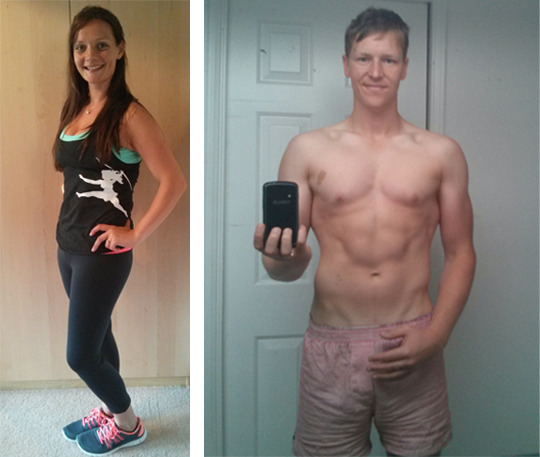
For the past few months the shifts in our weight have been more gradual, but we find that we both have reached our ideal body composition, given that we are both working, looking after two toddlers at home and I am also studying full-time for a PhD at the same time. My wife is slimmer and fitter now than she was before she had kids. She often skips meals without even noticing it and her skin is glowing all the time now. For my part, I have never been this fit in my life with my energy levels constantly being high. When I am asked what type of workout I do, I feel embarrassed to say that I do not follow any particular program. I do pull-ups, dips and push-ups on a daily basis, but never a completely fixed number or set of exercises. I do what I feel like, for example, when the weather in Scotland is not too wet and windy (remember this is a country where you can literally experience all three seasons: Fall, Winter and Spring in one day), I will strap on my 26lbs weight vest, one kid in a rucksack on the back and one in a sling in the front and go hiking in the hills for 30mins.
 Having said that, the flexibility that the Primal lifestyle allows us is the biggest benefit in my eyes. If we spent a few days without breaking a sweat then that’s ok. Equally, just having been on holiday in wonderful California, I am able to hike with the kids in the morning, rest at lunchtime in the sun and then go out kayaking with my boy. The Primal lifestyle is extremely individualistic and everybody can really just do what their bodies tell them and still get into fantastic shape. I feel I have much more energy for a wider variety of activities than especially in comparison to my gym-marathon times.
Having said that, the flexibility that the Primal lifestyle allows us is the biggest benefit in my eyes. If we spent a few days without breaking a sweat then that’s ok. Equally, just having been on holiday in wonderful California, I am able to hike with the kids in the morning, rest at lunchtime in the sun and then go out kayaking with my boy. The Primal lifestyle is extremely individualistic and everybody can really just do what their bodies tell them and still get into fantastic shape. I feel I have much more energy for a wider variety of activities than especially in comparison to my gym-marathon times.
Another important revelation of our Primal journey has been that we need to pass on these eating and movement habits to our children, albeit them still being very young. It has been very interesting to see that both of them enjoy their Primal lunches of avocado, meat, cucumber and carrot sticks much more than the previously served good old wholegrain sandwich. Also, they both love beef jerky and we have now our own food dehydrator so we can make our own organic jerky. With our kids we have experienced much more stable energy levels with hardly any mood swings as well as our son showing a huge reduction in the eczema that he has been suffering from for nearly two years.
Finally, I wanted to share a thought with you that has accompanied me over the past half year. My life always seems to be very busy with a lot of demands. Especially with us having two young children, it got to a point where I was not too sure that I could manage it all. The transformation that both my wife and I have experienced, however, gave me a daily proof that anything is possible if we put our minds to it and the extra energy from our Primal lifestyle has led to a huge productivity boost. Having gone Primal has not simply shifted body fat for us, it has changed our enjoyment of life and we are hopeful that our story might help someone, who is not too sure about it all to simply give it a go and experience another Primal transformation along the way!
Thank you,
Tobi and Harriet Emonts-Holley
Have You Seen the New Book? Get Your Copy of The Paleo Primer and Claim Your FREE Gifts While the Special Offer Lasts

August 8, 2013
15 Concrete Ways to Play
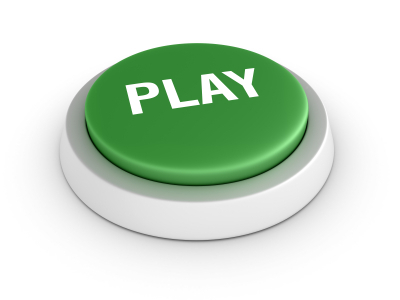
Picture yourself around 2:30 on a work day. The mid-afternoon lull settles in – the time when you reach for a cup of coffee, a distracting snack, Facebook updates, or the time you tend to get up and simply wander the halls as long as you think you can get away with it. Maybe you’re bored with what you’re doing. Maybe you’re feeling tired, frustrated, crabby, or just confined. You look out the window (if you’re fortunate enough to have one) and mentally wander into the land of 10,000 things you could be doing right now instead of work. Myriads of enjoyable and inspiring ideas lead you down tempting mental paths of play all in wondrous childhood proportion. Eventually, you come back to reality but vow to make your weeknight/weekend/coming vacation all about the visions you’ve just had. Problem is, when the time comes, it’s hard to recall the ideas let alone the enthusiasm.
Enter simple strategy… When the kids were little, we kept an idea jar – just some old container where we put slips of paper with good ideas – the ideas we knew we wanted to do with the kids but knew we would never remember in the usual haze of regular parenting days. How about we call this the beginnings of a Primal play receptacle? Be kind and add to it! (Hat tip to W.J. Purifoy for the inspiration for this post. Not knowing how to play is, unfortunately, a very common problem among us adult types!)
1. Create – and enjoy – a human agility course in your backyard.
Why should dogs have all the fun? “Collect” natural materials (e.g. boulders, logs) from gracious friends or neighbors (no late night yard robbing, please) as well as ropes, pulleys, tires, and whatever else suits your fancy.
2. Find mud.
There is no limit to what you can do with and in mud. The only rule is you must be dirty enough to make Mr. Clean cry.
3. Create music – your own – preferably with others.
Your guitar is sick of sitting in the case. The piano is dying a slow death of abandonment. Even your kids’ old recorders, harmonicas, and bongos are begging to be of use again. Round up the kids – even if they’re sullen teenagers at this point. Call the neighbors or your brother. March down the street with the little ones, or sign up for an open mic night. If you can’t play anything, sing or dance. Doesn’t matter. The idea is participation in something live and living.
4. Do a moonlight hike.
Why do we feel the need to flee indoors the minute the sun sets? Some of the best times I’ve spent outdoors have been at night. There’s something about night hikes (and night trail runs) that just leaves me energized. Call it the right blend of quiet and vigilance. A lot of local parks and outdoor clubs organize full moon hikes – especially in the summer. (Look for full moon snowshoeing come winter.)
5. Spend an entire afternoon in water.
Not an hour – an afternoon. Give your mind time to relax. Give your imagination time to reclaim its wild, Primal, kid depth and dimension. Swim, splash, float, explore, fish, chase, wade, paddle, revel. Be amphibious. I promise it’s fun.
6. Scout every park and preserve in your area for good tree climbing.
What are you favorite trees to climb? Can you answer this question? If not, consider it an invitation to get out more. Pick up an area map of nearby parks and preserves. Establish a weekly outing for just this purpose (with a Primal picnic afterward if you need extra incentive), and make the rounds.
7. Sign up for an art or craft class.
This could mean everything from pottery to carpentry. There’s just something therapeutic about absorbing yourself in an art or craft. One dear friend got through the first year after her husband’s death by learning to wood carve and chair weave.
8. Buy a bag of army men at the dollar store and place them in strategic spots throughout your work place (or roommate’s room).
Because why not.
9. Spend a day working with rocks and sand.
Make a labyrinth, a human-sized Zen garden or just funky rock configurations in your yard. Get a special delivery of from your favorite landscaping supply company, and go to town. Can you imagine a better Primal workout?
10. Go rock hunting.
I’m not suggesting pillaging fragile ecosystems. Follow laws and logic. Beyond that, consider it more cool stuff for your Zen garden!
11. Create your own Amazing Race style competition.
Do you have an adventurous group of friends and acquaintances? (If not, make a Meetup!) Whether you make it an urban challenge or a foray into the wilds of a larger park or preserve, you gotta love the head rush of a good competition.
12. Spend the day with a shelter pet.
Some shelters allow people to volunteer as dog walkers. See if they’ll let you relax the rules and take the dog for a whole afternoon. Go to the beach, the local trails, your cousin’s farm – wherever fun and adventure can be had. You’ll benefit from the good you’re doing, and at the end of the day it will be a toss up who showed whom the better time.
13. Revisit Primal WOW workouts.
“Primal Skirmish” or “Brave the Weather” anyone? Think fractal, intense, messy, taxing, exhilarating, and sometimes a wee bit competitive.
14. Perform stupid human tricks, deranged relay races, or mad feats of strength.
I’m sure everyone here could come up with enough ideas to stock a book in and of itself. Hmm…maybe something to that. Think farcical sprints like pushing a wheeled office chair down the street back and forth as fast as you can. If you can get friends who are up for a race (with riders in said seats – helmets, please), it would be so much better. See how high in trees or over roofs you can throw old shoes. Hurl tires in the yard (be sure to grunt). You get the idea. Nothing like keeping the neighbors guessing…
15. Take your kids – or friend’s/family member’s kids – on a nature day or (if you’re brave) a camping trip.
See a trail or open field through young eyes again. Sticks will quickly become swords. Mossy logs will turn into fairy houses. Streams and ponds will be inevitable afternoon detours. Many things will be “gross,” but just about everything will be endlessly fascinating. Trust me – you’ll all sleep well when the day is done.
Favorites – and additions to the list? How are you getting out and playing in new ways since going Primal (or going deeper)? Thanks for reading, everyone. Have a great end to the week.
Have You Seen the New Book? Get Your Copy of The Paleo Primer and Claim Your FREE Gifts While the Special Offer Lasts

August 7, 2013
Change Your Mind. Change Your Body. Get Creative in the Kitchen!
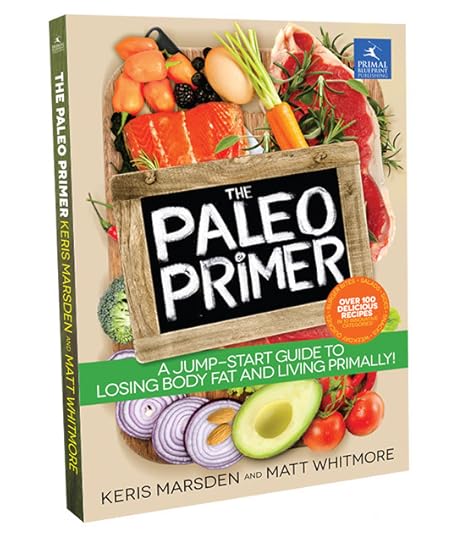 I am pleased to announce a special release of The Paleo Primer, the latest publication from Primal Blueprint Publishing, and a wonderful new book from British health and fitness consultants Keris Marsden and Matt Whitmore (this book is an adaptation of their popular UK release called Fitter Food). When Keris and Matt first shared their work with me, I knew immediately it was something special. These folks, who run a popular fitness and wellness center called Fitter London, have produced a book that is half “primer” and half incredibly creative recipes. The primer section distills the major concepts of primal/paleo/ancestral health living into clever and memorable short passages, spiced up by hilarious cartoon drawings.
I am pleased to announce a special release of The Paleo Primer, the latest publication from Primal Blueprint Publishing, and a wonderful new book from British health and fitness consultants Keris Marsden and Matt Whitmore (this book is an adaptation of their popular UK release called Fitter Food). When Keris and Matt first shared their work with me, I knew immediately it was something special. These folks, who run a popular fitness and wellness center called Fitter London, have produced a book that is half “primer” and half incredibly creative recipes. The primer section distills the major concepts of primal/paleo/ancestral health living into clever and memorable short passages, spiced up by hilarious cartoon drawings.
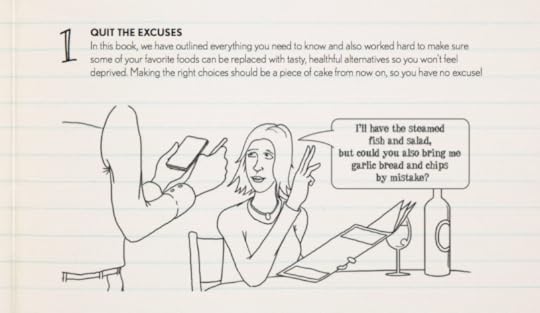
It’s a quick and easy read that makes this book a perfect gift to introduce newcomers to the movement without intimidating them. Their writing style is pleasant and breezy, not at all heavy handed or exclusionary. After all, Matt and Keris are in the business of helping everyone who strides through the door of their facility, and they strike a very welcoming tone in the book. What’s heart warming is how Matt and Keris put their heart and soul into the publication of this book. To harvest the necessary funds, they moved back home with Matt’s mom, took over her kitchen, and made her head recipe tester. The planned six-month project to produce a recipe booklet for clients morphed into this two-year project and world wide book release. In the process, Matt’s mom went Primal (how could she not?) and lost two stone (that’s a lot – look it up!)
The second half of the book is filled with some of the most creative and delicious recipes I have seen anywhere. As I reflect on the saturation of the market with paleo cookbooks over the past two years, I have actually wondered aloud if anyone ever needed another paleo recipe book. Well, I can state enthusiastically that these recipes are going to stand out the moment you see them. When I flipped through the recipes, I found myself making notes on sticky pads and heading to the kitchen to try this and that right away. One thing that some of my male friends who saw the book early mentioned (and you could charitably call these guys, “non-chefs”) was that these recipes were “easy”. That is, many have minimal ingredients and instructions, making them not only dummy proof, but inspiring to try for even a casual cooker. To me, this is really important, because I know not everyone has the time or the inclination to get really deep into creation in the kitchen.
Download the PDF excerpt above here (large PDF).
The recipes are organized into ten clever categories (e.g., Paleo Comfort Food; Cheats of Champions; Top Burger Bites), each with clear instructions and beautiful photographs. All of these delights are original creations from scratch, about as creative as you can imagine, and low carb to boot. The self-proclaimed burger King and Queen of England, Keris and Matt share seven mind-blowing burger preparations (Pesto Pork Cupcakes, anyone?) along with countless other main courses that pass the mouth-watering test, including: Baked Tomato Salmon, Sundried Stuffed Chicken Breast, Chili Roasted Macadamias, Cinnamon Coconut Squash, and Kale Chorizo Mash. And for those of you keeping a close count on carbs, there’s a complete nutrition index listing the fat, carb, protein and calorie content of each dish.
The Paleo Primer Podcast Interview
Listen to a podcast interview with authors Matt Whitmore and Keris Marsden. In this lively 30-minute discussion with PBP’s Brad Kearns, Matt and Keris talk about the amazing journey they took to get this book published, the health problems they experienced that led them to adopt Primal living principles, the positive feedback they’ve received about the Fitter Food release, and how they NEVER repeat the same workout at Fitter London (going on five years now!)
http://marksdailyapple.com/images/downloads/PaleoPrimerPodcast_Aug2_2013.mp3
Download the Paleo Primer Podcast (right click to “Save As”)»
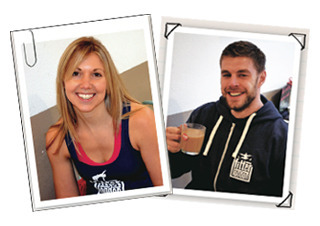 While the knowledge base and the expert voices of the movement are growing impressively, cutting to the chase can be quite appealing to those of us leading busy lives and looking for simple, direct guidance for what, why, and how to improve dietary habits, exercise strategies, and general health in the ancestral model. With The Paleo Primer, Matt Whitmore and Keris Marsden have done a masterful job doing just that, creating an extremely creative, fun, and informative book to help you get healthier and enjoy the process.
While the knowledge base and the expert voices of the movement are growing impressively, cutting to the chase can be quite appealing to those of us leading busy lives and looking for simple, direct guidance for what, why, and how to improve dietary habits, exercise strategies, and general health in the ancestral model. With The Paleo Primer, Matt Whitmore and Keris Marsden have done a masterful job doing just that, creating an extremely creative, fun, and informative book to help you get healthier and enjoy the process.
Per Mark’s Daily Apple tradition, I’ve put together an exciting limited-time offer to order this book direct from PrimalBlueprint.com before it goes on sale to the general public. It expires on Saturday, Aug. 31, 11:59 pm PST. We really want you to try the recipes, so we’ve put together a couple different bonus packages to choose from. Go ahead and order multiple copies to gift to your friends; just write in the order notes any additional addresses you would like the book(s) shipped to.
BONUS PACKAGE #1:
Order 1 or more copies of The Paleo Primer for only $19.95 plus S&H from PrimalBlueprint.com and get:
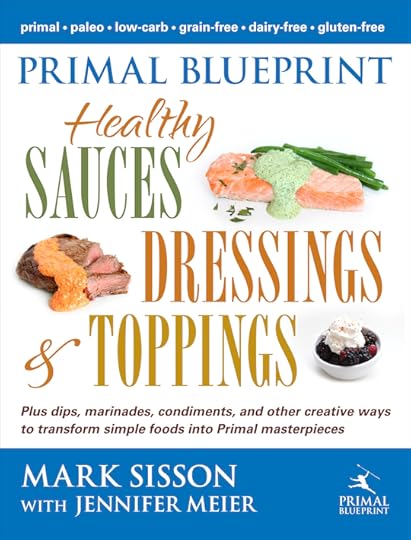 1. A FREE copy of Primal Blueprint Healthy Sauces, Dressings & Toppings (retail value $29.95). That’s right, buy one Primal book and get another one absolutely free.
1. A FREE copy of Primal Blueprint Healthy Sauces, Dressings & Toppings (retail value $29.95). That’s right, buy one Primal book and get another one absolutely free.
Primal Blueprint Healthy Sauces, Dressings & Toppings is all about turning ho-hum meals into Primal masterpieces with delicious and nutritious sauces, dressings, marinades, condiments, spice blends, gravies, and other toppings. It includes over 120 easy-to-prepare recipes inspired by traditional and contemporary cuisine from around the world. From the staples (ketchup, mustard, barbecue sauce, hot sauce, mayonnaise) to the innovative (Blueberry Chutney, Arugula Watercress Pesto, Avocado Lime Dressing), every recipe will enhance the nutritional value of your meal, using only Primal-approved ingredients. That means no gluten, grains, legumes, added sugar, or unhealthy oils.
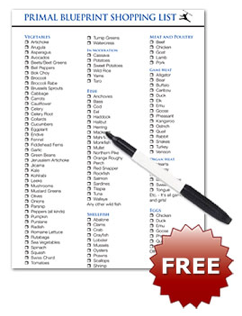 2. A FREE Laminated Primal Blueprint Shopping List and Pen.
2. A FREE Laminated Primal Blueprint Shopping List and Pen.
This Primal Blueprint Shopping List comes laminated in durable plastic and with a fine-point dry erase marker. Not sure if it’s Primal? Check the list.
Jerusalem artichokes? Check.
Macadamia oil? Check.
Gooseberries? Check.
Use the list every time you visit your local grocery store or farmers market and you’ll rest assured that you’re eating like Grok.
Click Here to Order The Paleo Primer and Get Bonus Package #1 for FREE>>
BONUS PACKAGE #2:
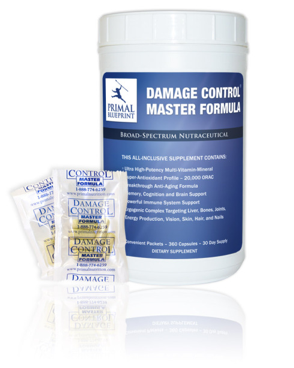 If you’ve been considering trying Damage Control Master Formula this offer’s for you.
If you’ve been considering trying Damage Control Master Formula this offer’s for you.
Damage Control Master Formula works synergistically with the Primal Blueprint eating and exercise strategies to support your immune system, maximize your own natural hormone production and balance, support normal blood sugar levels, lower stress hormone production, support the healthy structure and function of your brain and nerve cells and, most importantly, help combat oxidative damage in every cell of your body. It is a complete, well-balanced multi-vitamin-mineral, with added antioxidants, plant extracts and other important phytonutrients. I take Master Formula every day to ensure I’m covering all of my bases. For more on the logic behind Master Formula read the link above and this article.
Order Damage Control Master Formula on automatic delivery and get:
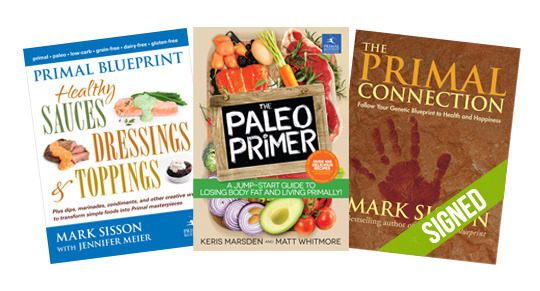
1. A FREE copy of The Paleo Primer (retail value $19.95).
2. A FREE copy of Primal Blueprint Healthy Sauces, Dressings & Toppings (retail value $29.95).
3. A FREE signed copy of The Primal Connection (retail value $24.95). The Primal Connection is the award winning sequel to my best-selling book The Primal Blueprint. It’s both a culmination and expansion of principles I’ve first introduced here on Mark’s Daily Apple, and it picks up where The Primal Blueprint left off. In it I describe a comprehensive plan to overcome the flawed mentality and hectic pace of high-tech, modern life and reprogram your genes to become joyful, care-free, and at peace with the present. Your free copy will come with my very own John Hancock.
4. A FREE Laminated Primal Blueprint Shopping List and Pen.
5. A FREE bottle of Vital Omegas – Omega-3 Fish Oil Capsules (retail value $24.95).
Click Here to Order Damage Control Master Formula and Get Bonus Package #2 for FREE>>
Many thanks to everyone that purchases one or more copies of The Paleo Primer over the next few weeks. Matt and Keris and the entire Primal Blueprint team and I appreciate your support and hope that this new book will touch your lives just as Mark’s Daily Apple and previous Primal Blueprint books may have in the past. Grok on!
Fine Print:
Unlike previous retail channel promotions, this one is simple: You order the book directly from PrimalBlueprint.com and we send you all the free bonus items. No worries, no hassles!
This special bonus offer ends at 11:59 pm, Aug. 31, 2013 (PST).
Only orders placed on PrimalBlueprint.com will receive the bonuses.
The Paleo Primer is not yet available on Amazon.com or at other retail locations.
Both domestic (U.S.) and international orders are eligible for the bonuses.
Bonus Package #2 only applies to orders placed for Damage Control Master Formula on automatic delivery. Non-automatic delivery orders of Damage Control Master Formula are not eligible for this special offer. You can cancel your 30-Day automatic delivery order at any time.
Get Your Copy of The Paleo Primer Today!

August 6, 2013
How to Turn Your Nature Deficit Into a Nature Surplus
 This summer I got an unmistakable itch. A yearning. A calling. It happens every summer. I start getting these admittedly ridiculous, unrealistic, impossible, and yet somehow still unavoidable and alluring thoughts about ditching civilization for a little cabin in the woods somewhere. Maybe a plot of land, some chickens, some livestock (not sure what, maybe cows, goats, and sheep, maybe a pig or two). There’s a river running through it, too, or at least a babbling brook, leading up to a big blue lake that you can see right through to the bottom even though it’s hundreds of feet deep. And trees everywhere, towering green giants that cover the sky and leave just enough room for me to stargaze and spot oncoming storms.
This summer I got an unmistakable itch. A yearning. A calling. It happens every summer. I start getting these admittedly ridiculous, unrealistic, impossible, and yet somehow still unavoidable and alluring thoughts about ditching civilization for a little cabin in the woods somewhere. Maybe a plot of land, some chickens, some livestock (not sure what, maybe cows, goats, and sheep, maybe a pig or two). There’s a river running through it, too, or at least a babbling brook, leading up to a big blue lake that you can see right through to the bottom even though it’s hundreds of feet deep. And trees everywhere, towering green giants that cover the sky and leave just enough room for me to stargaze and spot oncoming storms.
Or maybe it’s the jungle, or the beach, or the desert. Point is: I get this powerful urge to leave civilization behind and strike out for the wild of nature.
This is just a fantasy for me. I’ve never seriously considered taking the plunge and striking out, off the grid. I love my life, I relish my work, I like the creature comforts afforded by modern society, and I love my friends and family. Wouldn’t give that last one up for the world, especially. Why, then, do I still yearn for the wild?
We can’t live without nature. That’s why.
And I don’t mean in the sense that we obtain the very resources on which our lives depend from nature – food, water, shelter, fuel – although that’s true, too. What I mean is that without regular exposure to nature, even if “nature” is just going outside for some fresh air, a person can’t live a full, complete, happy life. It’s evident to me that for humans, like other animals, nature is the “default” environment. It’s the norm. It’s not that spending time in the woods reduces blood pressure, boosts immunity, and lowers stress, as seen in the forest bathing studies. It’s that spending too much time in cities and suburbs raises blood pressure, lowers our immune function, and increases stress. Nature exposure simply restores the normal physiological functions impaired by exposure to civilization. The end result is the same either way – better health – but thinking of nature as the norm and civilization as the aberration underscores the importance of the connection between people and nature and highlights just why nature is so vital for our health and well-being.
I’m not just listening to my gut here, either, nor am I basing my assertions entirely on a personal sentiment I might have. There exists a wide and growing body of scientific evidence supporting my position.
Some skeptics of the importance of the link between human health and nature have claimed that physical activity explains the association. In other words, the only reason green spaces are linked to improved health is that people who have access to green space are more likely to be active. It’s a compelling argument, but a recent study just determined that while some of the cardiovascular health improvements associated with urban green space are due to increased physical activity, it can’t explain all of them.
In one of the coolest pieces of research, one recent study measured the brain responses of people touching different things, including foliage from a plant, synthetic foliage made to feel like the real thing, a piece of fabric, and a piece of aluminum. They also asked the subjects to describe their feelings when touching the various objects. When people touched the metal, they evinced cerebral brain flows indicative of a stress response. When people touched the real leaf, they experienced a calming effect, but didn’t consciously realize it was occurring. The way they described how they felt didn’t change. So, it wasn’t just a subjective perception of relaxation. An actual connection to nature was happening on a physiological, measurable level, showing that our bodies know the difference between manmade and natural. Almost like we’ve evolved some intrinsic interface with the great outdoors, eh?
So, today, I want you to start addressing the nature deficit in your lives. We all have one. Consider this a call to arms, and use this opportunity to make a statement of intent, a declaration of your plans to address the issue and turn your deficit into a surplus.
Remember that nature isn’t just “green.” You don’t have to plumb the depths of the deep forest, necessarily. Nature is also blue – rivers, lakes, oceans, creeks. In fact, “urban blue” is an emerging focus for researchers interested in the effects of nature exposure and human health. Nature is also brown – deserts, prairies, beaches. Nature can be wildly colorful, too – jungles, meadows full of wildflowers. Nature is darkness, as well. Some of my strongest memories come from simply looking up on a clear black night to watch the universe unfold itself before me. What’s important here is getting a respite from civilization, from steel and concrete and car horns and WiFi and emails.
Explore less mainstream areas. A perfect example of this is Yosemite National Park in Northern California. Usually when I go, I make it a point to avoid Yosemite Valley. Sure, the valley is where all the big attractions are, like Half Dome, El Capitan, and the Mist Trail, but it’s also where all the tourists go. To most people, Yosemite is Yosemite Valley. But me? I like to go along Tioga Pass, which runs above the valley in the high country and has a ton of really cool stuff. Beautiful vistas, Lake Tenaya, Tuolumne Meadows, Lembert Dome, and several really great campgrounds that tend not to fill up, even in high season. The valley is certainly worth checking out, but sitting in a traffic jam is not my idea of “getting away.”
Try to incorporate a bit of nature into your life every single day. This doesn’t require moving out to the sticks. Luckily, we can fool ourselves with approximations or phantoms of the real thing. Do some gardening out back or on your windowsill. Buy some houseplants. Go for a walk in the park. Take a nap in the grass. Listen to some nature sounds as you work or try to sleep.
Spend the better part of a day in the outdoors at least once a week. You might have to drive an hour or two. You might have to settle for a local park, or even your backyard. Whatever you do, just try to fully immerse yourself in some natural setting for at least one day a week. You don’t lose or anything if you can’t make it happen, of course. Just think of this as a goal to shoot for.
Make time for extended nature-inspired trips several times a year. A few times a year, spend two or more days getting dirty, building fires, camping, hiking, swimming, fishing, hunting, snorkeling, climbing, surfing, snowboarding, or just generally roughing it in whatever manner the season, location, and climate allows. For some people, this will be a safari in South Africa. For others, it’ll be a camping trip to the local lake.
Just do it. We usually have the idea that diet and exercise are the ultimate arbiters of health. If you’re talking body composition, yes, I’d agree. But if you take mental and spiritual health into account, I don’t think we can think of nature exposure as extra-curricular or optional. It’s absolutely vital. Don’t skip this stuff. Make the effort, just like you make the effort to avoid grains, refined sugar, and vegetable oils.
Okay, that’s it for my spiel. As you can tell, I care about this issue, and I think you should, too.
Now, let’s hear from you. Where are you going to go? What steps are you going to take to get more nature in your life? Let me and everyone else know in the comment section! Thanks for reading!
Get Your Omega-3s: Order Two Bottles of Primal Blueprint Fish Oil Capsules and Get An Additional Bottle Absolutely FREE

August 5, 2013
Dear Mark: Paralysis by Overanalysis, Beer, and Liquid Coconut Oil
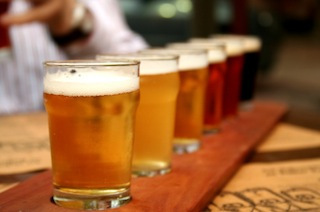 For today’s edition of Dear Mark, we’ve got three questions to cover. First up is a question from a reader who feels paralyzed by too much health information. Whereas before the basics might have made sense to him, digging further into the literature and the blogs is only making it harder and harder to make the right choice, or any choice at all. I totally understand and can relate. Next, I discuss the possible negative health effects of beer. Is it just the gluten that’s a problem, or are there other issues as well? Finally, I explore liquid coconut oil, or coconut oil that’s been altered to remain liquid at any temperature. Is it safe? Is it Primal? Is it actually worth using? Find out the answers to all these questions in today’s Dear Mark.
For today’s edition of Dear Mark, we’ve got three questions to cover. First up is a question from a reader who feels paralyzed by too much health information. Whereas before the basics might have made sense to him, digging further into the literature and the blogs is only making it harder and harder to make the right choice, or any choice at all. I totally understand and can relate. Next, I discuss the possible negative health effects of beer. Is it just the gluten that’s a problem, or are there other issues as well? Finally, I explore liquid coconut oil, or coconut oil that’s been altered to remain liquid at any temperature. Is it safe? Is it Primal? Is it actually worth using? Find out the answers to all these questions in today’s Dear Mark.
Let’s go:
Your link to the Bulletproof coffee guy in your article about Primal Coffee lead me to his article about the downsides of raw kale. After I read that, now I’m worried about oxalates and goitrogens. More broadly, the more I read on sites like MDA and others, the less I feel like I know about how to live healthfully. Between Omega 3:6 ratios, calcium:magnesium ratios, mycotoxins in coffee and chocolate, and all the other “if you eat this, it should be paired with this otherwise you’re screwed”, it really is hard to know how to live.
Any thoughts?
Thanks very much!
Jason
Don’t sweat the small stuff, dude. Don’t let the perfect become the enemy of the good. It’s usually far more trouble than it’s worth.
Some people actually enjoy sweating the small stuff, and that’s cool, too. They like geeking out on nutrition. I’m that way to a certain extent, but once I feel like it’s impeding on my life, once it’s worming its way into my brain and getting in the way of just being, I back off and tell myself not to sweat it. Since significant numbers of the Mark’s Daily Apple readership do qualify as nutrition geeks, I tip my hat to them (you!) quite often, but I try to maintain an undercurrent of relaxation. It can be hard to do, I’ll admit, which is probably why you sometimes feel you’re paralyzed by over analysis.
The key is to figure out what the “small stuff” actually is. That way, you can discard it and focus on the information that actually deserves your time.
Look: the bulk of your body comp comes from what you eat, and you get by far the most bang for your dietary buck by tailoring carbs to your activity levels and avoiding grains, seed oils, and refined sugar. Seriously, that’s the big takeaway from all this and for most people, it’s probably enough to get you most of the way to your goal.
I employ the 80/20 system for just this reason: eating Primal 80% of the time is good enough for most people. Heck, unless you’re celiac or highly sensitive to gluten, you can probably get away with eating bread at a restaurant or having a slice of pizza every now and then. I’m not saying it’s “healthy,” per se, but I am saying it’s not going to make you “unhealthy.” Obviously, if you have a bad reaction to that slice of bread, it’s probably “unhealthy,” but it’s self-correcting; you’re not going to do something that makes you feel bad. That’s kinda why we feel bad in the first place, to dissuade us from the pursuit of unsafe behaviors. Is there a chance that every slice of bread takes ten days off your life? Maybe. I highly, highly doubt it, though. Personally, it always makes me pay for it the next morning, so I avoid it. That’s me, though.
(Please don’t construe the preceding paragraph as “Mark Sisson says we can eat pizza!” It’s just a built-in anti-stress mechanism.)
He who tries to be perfect (based on someone else’s analysis of what exactly constitutes “perfect”) runs the risk of incurring massive amounts of stress, all for a few potential upticks in health/performance/body comp/whatever-metric-you’re-shooting-for. To me, it’s just not worth the effort.
Some examples of small stuff, as I see it?
Most people can sauté some kale without pre-steaming and squeezing all the oxalate-laden water from it and be okay. If you suspect you have oxalate issues, and taking steps to minimize oxalates seems to make you healthier, then go for it! If you’re doing fine, don’t stress about it.
Most people can just have a cup of regular coffee. Sure, if you drink coffee brewed from wash-processed, single-origin microlot beans grown at the perfect altitude, handpicked by canopy-raised howler monkeys, and roasted at the local 3rd wave roasters who have a time machine that lets them roast beans in the future and therefore ensure the freshest coffee possible, it’s going to be really good and probably healthier and more antioxidant-rich, but I don’t think everyone needs to drink it to enjoy coffee. After all, the preponderance of the evidence for the health benefits of coffee is based on regular people drinking “regular” mainstream coffee like Starbucks, Peet’s, and Dunkin’ Donuts, not standing in line for pour-over coffee served up by bearded guys in flannel. Same goes for dark chocolate.
Not everything is small stuff, of course. The omega-3:omega-6 issue really does matter (perhaps the biggest change to people’s diets in recent years has been the astronomical rise in the amount of omega-6-rich seed oil we eat), as that affects our inflammatory response to stressors and injuries and illness – it basically changes the available substrate for the various inflammatory cytokines, biasing an exaggerated inflammatory (O6) over an anti-inflammatory (O3) response. Since low-level, chronic inflammation characterizes many, if not most, of the degenerative diseases afflicting us today, I’d say we should heed our omega-6 intake as it relates to our omega-3 intake. But shooting for a specific ratio? I don’t know that it matters all that much. Avoiding seed oils and eating oily fish (or take fish oil supplements when good oily fish is unavailable) is good enough and will likely get you close to the “optimal ratio.”
Same for calcium-magnesium. While people generally need to eat more magnesium, they don’t need to obsess over the specific ratio of calcium to magnesium. Just eat more leafy greens, incorporate some nuts and seeds now and then, take epsom salt baths, make (and rub onto your body) magnesium oil, swim in the ocean, and drink mineral water, preferably not all at once. Take a good magnesium supplement, even.
I always suggest that people in your predicament take a step back, revisit the 10 Primal Blueprint Laws, and get a handle on what really matters. Is there fine-tuning to be done? Sure. But if you stick to the basics – you know, the stuff that initially attracted you here – and view the nitty-gritty details as interesting data to think about and experiment with, you’ll probably do okay.
If it’s any consolation, what my years of research into all the nitty-gritty details have taught me is that the basics will get you most of the way there.
Mark,
I have scoured your site for info on how bad beer is. I have found it doesn’t effect me negatively after a period of removal and reintroduction, but I am concerned there might be more to it than feeling the effects. The only info I found is from your section on alcohol that states the carb count isn’t worth it. Are carbs the only real concern when drinking a craft beer since most beers I could find info on were in the range of 5-25ppm of gluten (excluding wheat beers)? Or is the gluten a concern as well at such a low ppm. As a homebrewer I have options for final carb count and final gluten levels, but just wanted to see a more in depth look at beer and its effects since I believe it is a common vice among your primal followers. Thanks!
John
There are a few potential concerns with beer.
The alcohol, first and foremost. Alcohol is a toxin (with some potential dose-dependent benefits), after all. Beer usually isn’t very high in alcohol by volume (although even that’s changing with the influx of higher ABV craft beers), but folks tend to drink enough volume to reach harmful levels. Having a meal in your belly before cracking the first beer can help here, as can following best practices for harm reduction/hangover prevention.
The phytoestrogens. Hops, an almost universal beer ingredient, are an incredibly rich source of phytoestrogens, or phytochemicals which interact with our estrogen receptors. Soy is often maligned and avoided for its phytoestrogen content, but the hop phytoestrogen has ”an activity greater than other established plant estrogens.” Is this a problem? Potentially, depending on how much beer you drink and how hoppy you like it. Ultra-hoppy IPAs, for example, should have more estrogenic activity than milder lagers. And, depending on where you look, phytoestrogens are both good and bad for us. Claimed benefits include relief from menopause (due to the estrogenic activity, phytoestrogens may act a bit like hormone replacement therapy), protection from osteoporosis (though RCTs have been mostly inconclusive), and a reduction in LDL levels (an effect that may be attributed to the soy protein, rather than the phytoestrogens). Claimed detriments, which I find to be both more persuasive and worrisome, include disrupted neuroendocrine development and ovulation, increased breast cancer for predisposed women, and abnormal sexual development. All that said, beer isn’t consumed like soy-eaters consume soy – as a staple food. The occasional beer – even an IPA – should be okay. Just be careful with the dosage.
The gluten, as you alluded to. Though most beer is made from barley, a gluten-containing grain, current testing does indicate minimal levels of gluten present in the finished product. One problem with this? Depending on the method used to test the beer, you get different results. For example, using ELISA, the standard method, a beer might show up as gluten-free. Using mass spectrometry, that same beer could test positive for moderate levels of gluten. Heck, according to Aurochs Brewing, a gluten-free beer maker, “no test effectively (and definitively) determines gluten content in beer.”
Beers are somewhat carb-dense when compared to other alcohols, but at between 10-20 grams per 12 ounce serving (and less for light “beer”), they’re not exactly in the realm of sodas, candy bars, and cupcakes. It’s only when you start drinking two, three, six beers, along with the wings and the pizza and the breadsticks, that beer-related carbs become an issue.
Overall, beers are pretty unPrimal. But if you can drink them without ill effect, I don’t think the occasional glass or bottle will do you much harm. Celiacs and gluten-sensitives should definitely steer clear, or opt for wine, cider, or other choices.
Hi Mark,
What’s your take on liquid coconut oil (such as NuCo)? What do they do to the coconut oil so that it remains a liquid at room temperature?
Thanks for any insights you may provide.
Suzanne
Coconut oils are liquidized by removing the long chain fatty acids and leaving the medium chain triglycerides. The removal process is entirely physical and uses no chemicals or solvents. No mutant fats are created, and the medium chain triglycerides remain intact and unaffected. This is similar to MCT oil, which is usually made from a combination of coconut and palm kernel oils. MCTs have a number of benefits:
They require less bile acid to digest, so people with impaired fat digestion can digest them more easily than longer-chained fats. MCTs actually increase the ability of a person to oxidize longer chained fats, too, making them especially useful for improving an impaired fat digestion (as well as burning body fat).
They are converted readily into ketones regardless of the carbohydrate content of the diet, so people on a ketogenic diet can use MCTs to generate ketone bodies without having to eliminate most of their plant foods. If you know someone – a grandparent, perhaps – who could probably use some ketones in their lives for the cognitive benefits, it’s a lot easier to slip some MCTs into their morning coffee than it is to get them to switch to a ketogenic diet.
They increase the metabolic rate, an effect that persists for about a week after ingestion.
They seem to have beneficial effects on lipid and metabolic profiles. For instance, in men with high triglycerides, MCT-feeding improves blood lipids and reduces abdominal and overall body fat, and in type 2 diabetics, MCTs improve insulin sensitivity.
If there’s anything to worry about here, it’d be that since MCTs always naturally occur in the presence of other, longer-chained fatty acids and never in isolation, the doses found in these refined oils may be supraphysiological with undesirable or untoward metabolic effects. There’s the oft-reported intestinal upset and subsequent diarrhea that comes with large doses of medium chain triglycerides, but that’s also been reported with straight coconut oil and usually clears up after several days of eating it. While I doubt there’s anything else serious enough to worry about, especially with the proven benefits, it’s something to keep in mind. Myself, I prefer coconut oil to MCT oil.
That’s it for today, folks. Thanks for reading and be sure to sound off below!
Get Your Omega-3s: Order Two Bottles of Primal Blueprint Fish Oil Capsules and Get An Additional Bottle Absolutely FREE

Mark Sisson's Blog
- Mark Sisson's profile
- 199 followers



